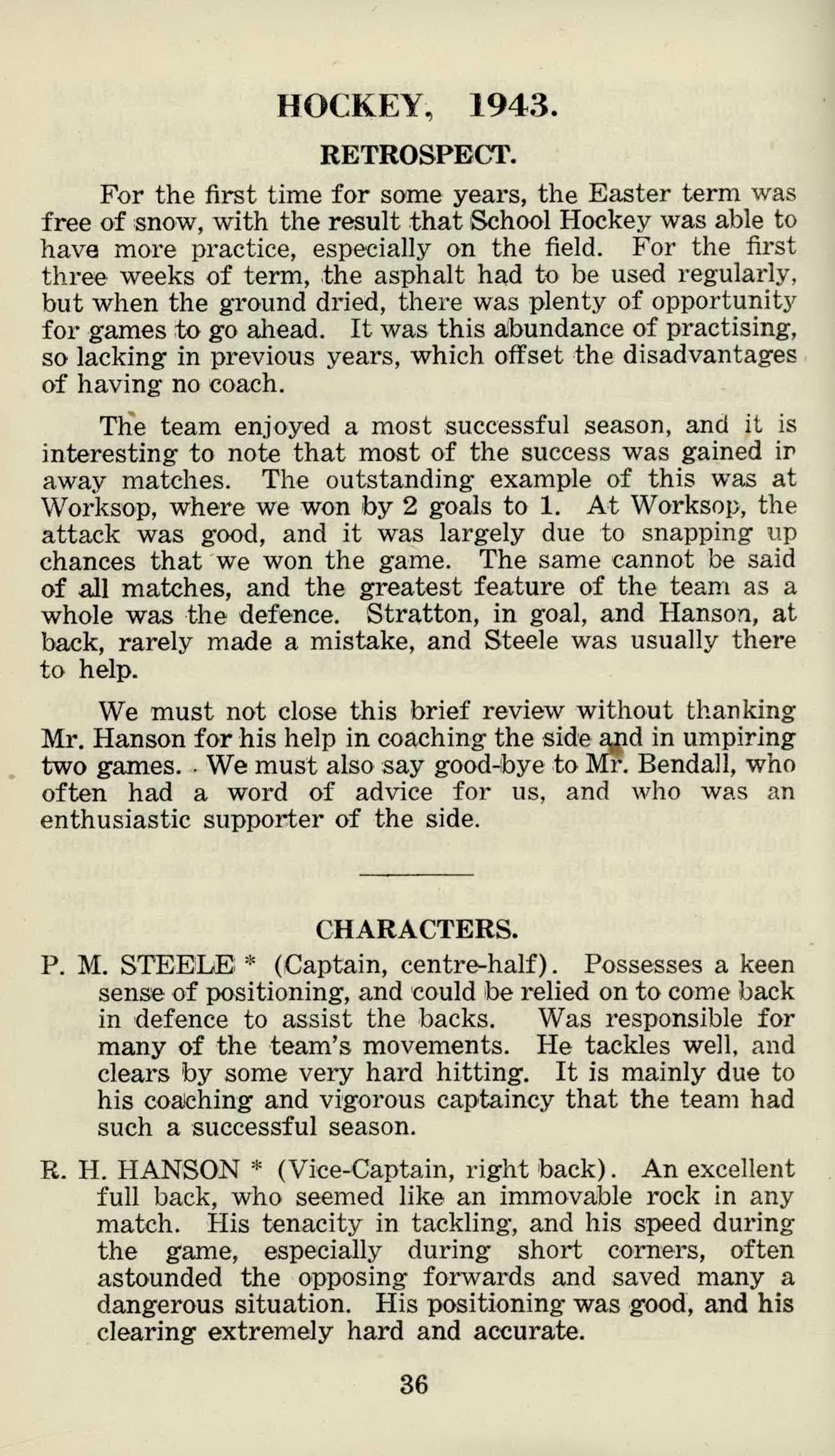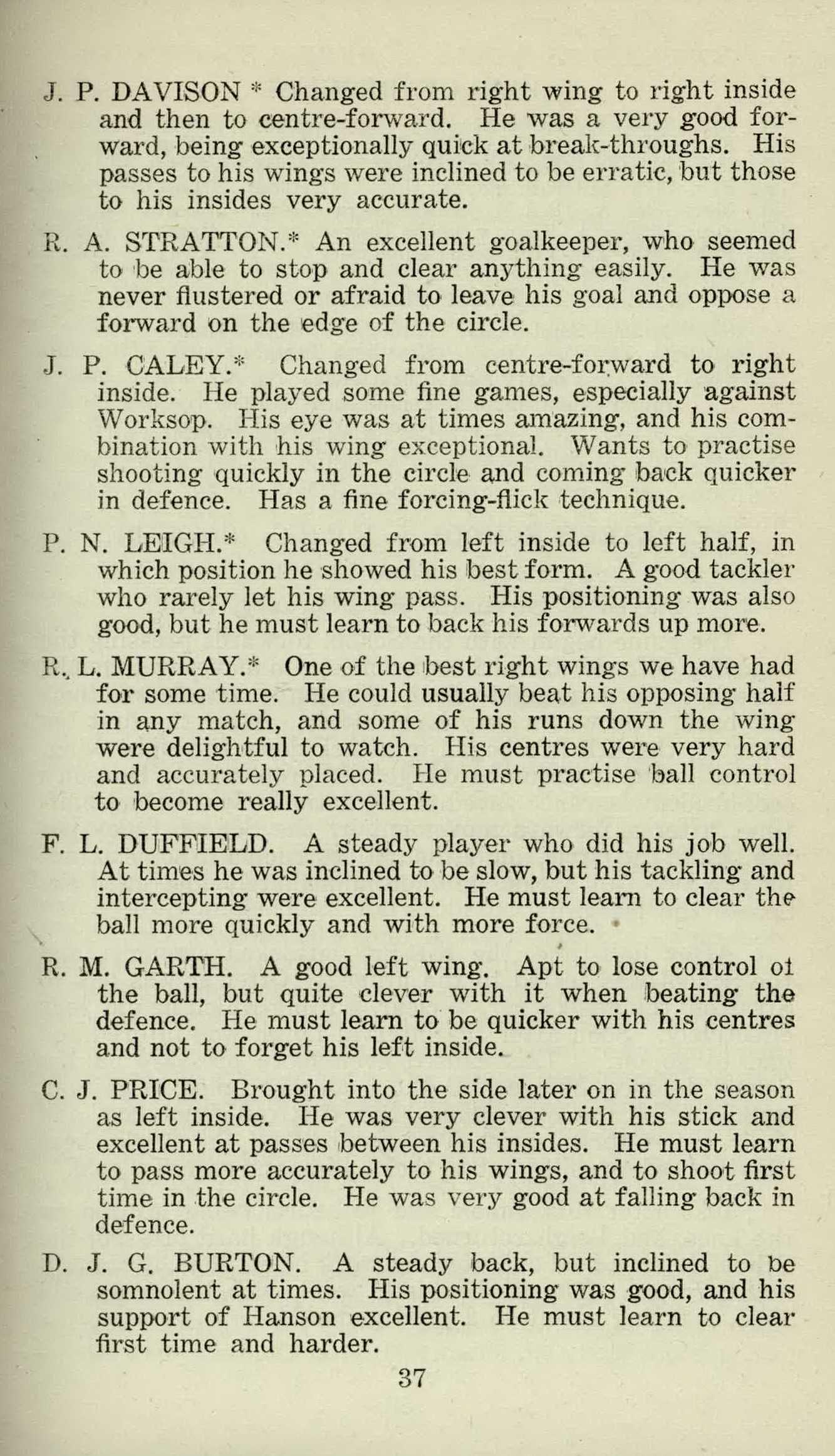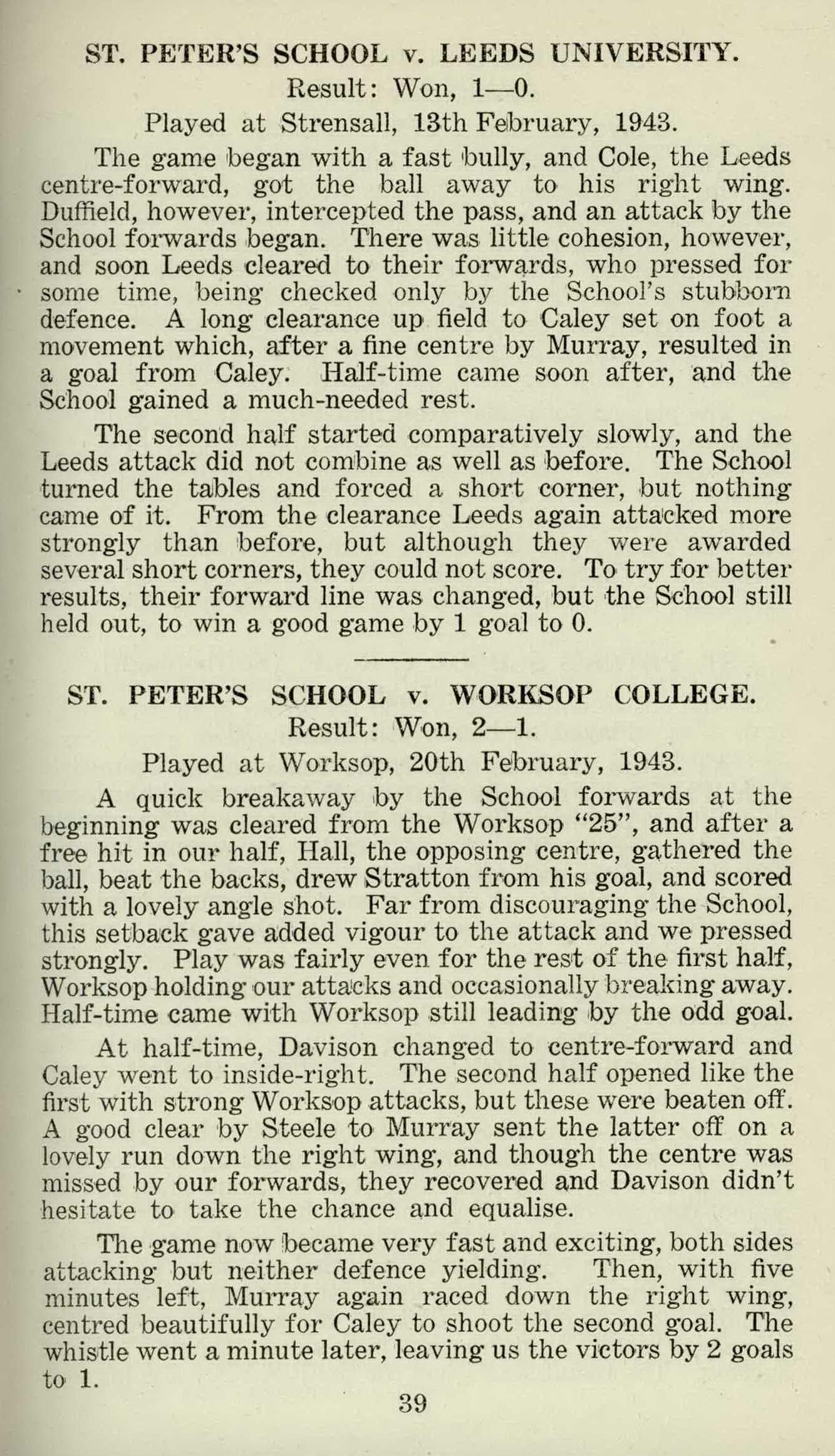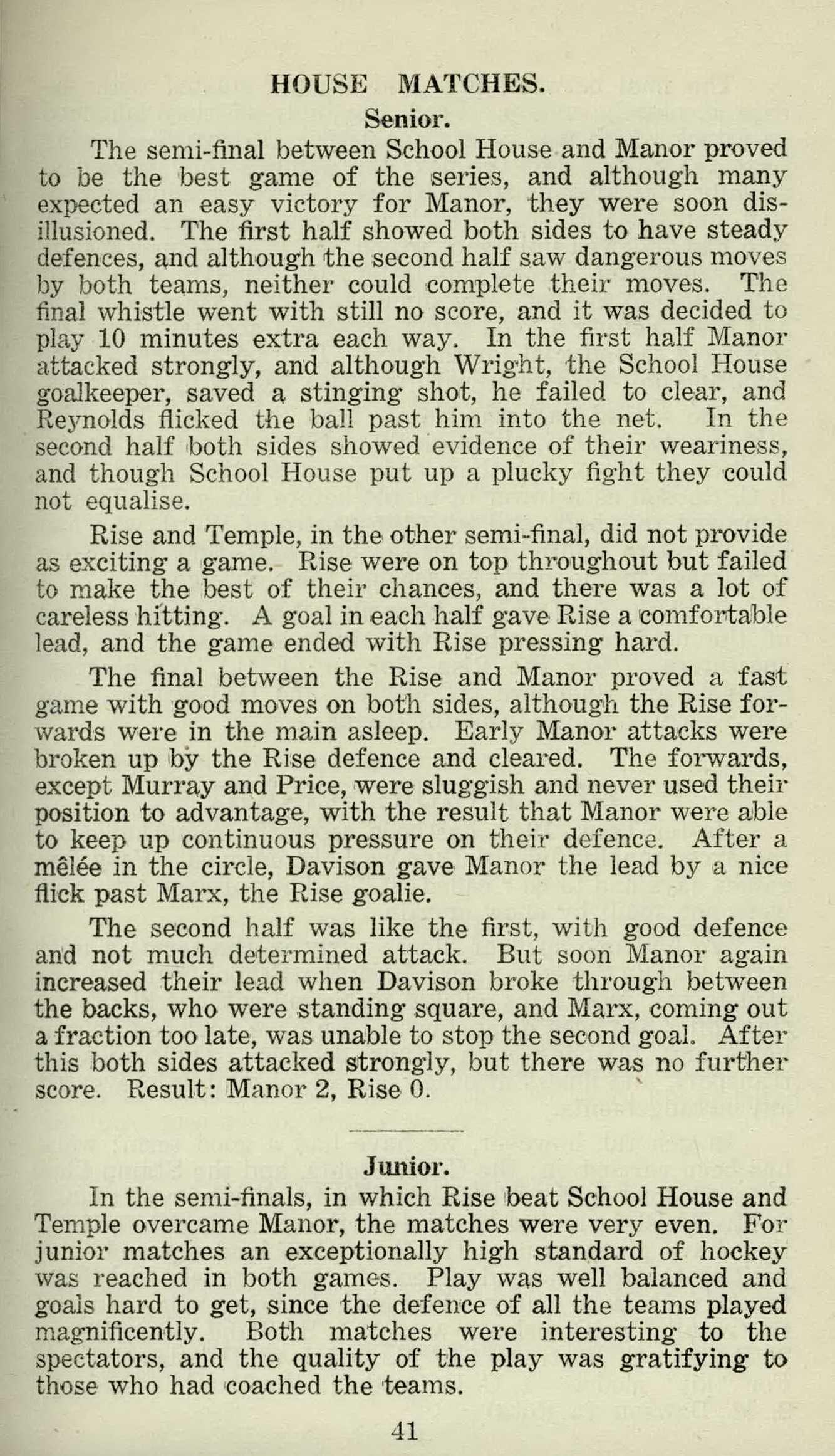
12 minute read
Hockey
from May 1943
by StPetersYork
HOCKEY, 1943.
RETROSPECT.
For the first time for some years, the Easter term was free of snow, with the result that School Hockey was able to have more practice, especially on the field. For the first three weeks of term, the asphalt had to be used regularly, but when the ground dried, there was plenty of opportunity for games to go ahead. It was this abundance of practising, so lacking in previous years, which offset the disadvantages of having no coach.
Tice team enjoyed a most successful season, and it is interesting to note that most of the success was gained it away matches. The outstanding example of this was at Worksop, where we won by 2 goals to 1. At Worksop, the attack was good, and it was largely due to snapping up chances that we won the game. The same cannot be said of all matches, and the greatest feature of the team as a whole was the defence. Stratton, in goal, and Hanson, at back, rarely made a mistake, and Steele was usually there to help.
We must not close this brief review without thanking Mr. Hanson for his help in coaching the side a,pd in umpiring two games. . We must also say good-bye to M. Bendall, who often had a word of advice for us, and who was an enthusiastic supporter of the side.
CHARACTERS.
P. M. STEELE * (Captain, centre-half). Possesses a keen sense of positioning, and could be relied on to come back in defence to assist the backs. Was responsible for many of the team's movements. He tackles well, and clears by some very hard hitting. It is mainly due to his coaching and vigorous captaincy that the team had such a successful season. R. H. HANSON * (Vice-Captain, right back). An excellent full back, who seemed like an immovable rock in any match. His tenacity in tackling, and his speed during the game, especially during short corners, often astounded the opposing forwards and saved many a dangerous situation. His positioning was good, and his clearing extremely hard and accurate.
J. P. DAVISON * Changed from right wing to right inside and then to centre-forward. He was a very good forward, being exceptionally quick at break-throughs. His passes to his wings were inclined to be erratic, but those to his insides very accurate. R. A. STRATTON.* An excellent goalkeeper, who seemed to be able to stop and clear anything easily. He was never flustered or afraid to leave his goal and oppose a forward on the edge of the circle. J. P. CALEY.* Changed from centre-forward to right inside. He played some fine games, especially against
Worksop. His eye was at times amazing, and his combination with his wing exceptional. Wants to practise shooting quickly in the circle and coming back quicker in defence. Has a fine forcing-flick technique. P. N. LEIGH.* Changed from left inside to left half, in which position he showed his best form. A good tackler who rarely let his wing pass. His positioning was also good, but he must learn to back his forwards up more. R. L. MURRAY.* One of the best right wings we have had for some time. He could usually beat his opposing half in any match, and some of his runs down the wing were delightful to watch. His centres were very hard and accurately placed. He must practise ball control to become really excellent. F. L. DUFFIELD. A steady player who did his job well.
At times he was inclined to be slow, but his tackling and intercepting were excellent. He must learn to clear the ball more quickly and with more force. • R. M. GARTH. A good left wing. Apt to lose control of the ball, but quite clever with it when beating the defence. He must learn to be quicker with his centres and not to forget his left inside. C. J. PRICE. Brought into the side later on in the season as left inside. He was very clever with his stick and excellent at passes between his insides. He must learn to pass more accurately to his wings, and to shoot first time in .the circle. He was very good at falling back in defence. D. J. G. BURTON. A steady back, but inclined to be somnolent at times. His positioning was good, and his support of Hanson excellent. He must learn to clear first time and harder.

Sat., Jan. 23rd v. K.R.R.C. ... Away ... Drawn ... 1 1 Sat., Feb. 6th v. Leeds University ... Away ... Won ... 1 0 Sat., Feb. 20th v. Worksop College ... Away ... Won ... 2 1 Sat., Feb. 27th v. K.R.R.C. ... Home ... Lost ... 0 2 Sat., Mar. 6th v. R.A.F., Scarborough Home ... Lost ... 1 2 Sat., Mar. 13th—"A" Team v. Leeds University ... Home ... Drawn Sat., Feb. 6th-2nd XI v. Leeds University ... ... Away ... Lost
House Matches.
Senior—Semi-finals: Manor beat School House. Rise beat Temple. Final: Manor beat Rise. Junior—Semi-finals: Temple beat Manor. Rise beat School House. Final: Rise beat Temple.
ST. PETER'S SCHOOL v. K.R.R.C. (Strensall). Result: Draw 1-1. Played at Strensall, 6th February, 1943.
The game began with the School forwards pressing the opposing defence, and although some good moves were made, the other side managed to clear. The main obstacle was their left back, who was a very hard hitter. After the first ten minutes, the K.R.R.'s began to attack down the right wing, but although it assumed dangerous proportions, Hanson's cool-headed clearance saved the situation. Just before halftime, after a forward movement by the School, Caley got the ball in the circle, and although obstructed to some extent by the two full backs, he shot immediately and gave the School the lead.
After half-tithe, the K.R.R.C. attacked strongly, and the School was tested to the utmost. Often it was left to Stratton, the goalkeeper, to clear, a thing which he did very effectively. Soon after the interval Leigh was injured and had to go off. This caused even more pressure on the School defence, but several short corners failed to gain an equaliser for the opposition. But this could not last, and their centre-forward received the ball on the circle, beat Stratton, who rushed out to tackle him, and scored a goal.
Just after this, Steele had to retire, being injured on the knee, and Leigh returned. Although hard pressed, the School defence held out, sterling work being done by Hanson and Stratton. The final whistle went with the score still 1.-1, a fitting result to a good game.

ST. PETER'S SCHOOL v. LEEDS UNIVERSITY. Result: Won, 1-0. Played at Strensall, 13th February, 1943.
The game began with a fast bully, and Cole, the Leeds centre-forward, got the ball away to his right wing. Duffield, however, intercepted the pass, and an attack by the School forwards began. There was little cohesion, however, and soon Leeds cleared to their forwards, who pressed for some time, being checked only by the School's stubborn defence. A long clearance up field to Caley set on foot a movement which, after a fine centre by Murray, resulted in a goal from Caley. Half-time came soon after, and the School gained a much-needed rest.
The second half started comparatively slowly, and the Leeds attack did not combine as well as before. The School turned the tables and forced a short corner, but nothing came of it. From the clearance Leeds again attacked more strongly than before, but although they were awarded several short corners, they could not score. To try for better results, their forward line was changed, but the School still held out, to win a good game by 1 goal to 0.
ST. PETER'S SCHOOL v. WORKSOP COLLEGE. Result: Won, 2-1. Played at Worksop, 20th February, 1943.
A quick breakaway by the School forwards at the beginning was cleared from the Worksop "25", and after a free hit in our half, Hall, the opposing centre, gathered the ball, beat the backs, drew Stratton from his goal, and scored with a lovely angle shot. Far from discouraging the School, this setback gave added vigour to the attack and we pressed strongly. Play was fairly even for the rest of the first half, Worksop holding our attacks and occasionally breaking away. Half-time came with Worksop still leading by the odd goal.
At half-time, Davison changed to centre-forward and Caley went to inside-right. The second half opened like the first with strong Worksop attacks, but these were beaten off. A good clear by Steele to Murray sent the latter off on a lovely run down the right wing, and though the centre was missed by our forwards, they recovered and Davison didn't hesitate to take the chance and equalise.
The game now became very fast and exciting, both sides attacking but neither defence yielding. Then, with five minutes left, Murray again raced down the right wing, centred beautifully for Caley to shoot the second goal. The whistle went a minute later, leaving us the victors by 2 goals to 1.

ST. PETER'S SCHOOL v. K.R.R.C. Result: Lost, 2-0. Played at home, -27th February, 1943.
This return match with the K.R.R.'s promised to be exciting, but towards the end the effect of the heat on both sides became apparent. The first half opened with attacks by the Army side and their long passing seemed to worry the School defence. Two short corners were forced, but they were unsuccessful. A dangerous attack down the right wing, followed by a quick centre, found the opposing centre-forward unmarked, and although Stratton made a gallant effort, he could not stop the shot, and K.R.R.'s were one up.
The play on both sides after half-time was disappointing, and the sun was obviously affecting the teams. Play was fairly even for some time, but gradually the K.R.R.'s pressed us back, and after a mêlée in the circle they notched another goal. For the rest of the game we were mainly kept in our own "25", but right at the end there were two lovely breakthroughs by Murray, Which, unfortunately, had no result. The game ended with K.R.R.C. still winning by 2 goals to 0.
ST. PETER'S SCHOOL v. R.A.F. (Scarborough). Result: Lost, 2-1. Played at home, 6th March, 1943.
As in the previous match, the School again seemed to be half asleep. From the start the R.A.F. pressed hard, and their quick passing often beat the defence. The attacks down the right wing were especially dangerous, but the School held firm, and after about quarter of an hour's play we began to attack. A short corner was unsuccessful, but soon after Steele managed to put the School ahead with a well-timed shot.
The R.A.F. pressed even harder after this, and although the defence played very well, they could not clear the ball far enough. Eventually, after a tussle in the circle, the other side equalised with a hard shot into the left corner of the goal.
After half-time the School attacked down the right wing, but there was little cohesion, and the opposing defence beat off their efforts. Play remained even for some time, but the School was obviously tiring, and they had to fall 'back on the defensive. There were a few short corners, all unsuccessful, but even so, we could not relieve the pressure. After a mêlée on the edge of our circle, the opposing inside-left found a lucky opening and took his chance. The rest of the game was mainly uninteresting, both sides attacking without success. The result was a win for the R.A.F. by 2 goals to 1. 40

HOUSE MATCHES. Senior.
The semi-final between School House and Manor proved to be the best game of the series, and although many expected an easy victory for Manor, they were soon disillusioned. The first half showed both sides to have steady defences, and although the second half saw dangerous moves by both teams, neither could complete their moves. The final whistle went with still no score, and it was decided to play 10 minutes extra each way. In the first half Manor attacked strongly, and although Wright, the School House goalkeeper, saved a stinging shot, he failed to clear, and Reynolds flicked the ball past him into the net. In the second half both sides showed evidence of their weariness, and though School House put up a plucky fight they could not equalise.
Rise and Temple, in the other semi-final, did not provide as exciting a game. Rise were on top throughout but failed to make the best of their chances, and there was a lot of careless hitting. A goal in each half gave Rise a comfortable lead, and the game ended with Rise pressing hard.
The final between the Rise and Manor proved a fast game with good moves on both sides, although the Rise forwards were in the main asleep. Early Manor attacks were broken up by the Rise defence and cleared. The forwards, except Murray and Price, were sluggish and never used their position to advantage, with the result that Manor were able to keep up continuous pressure on their defence. After a mêlée in the circle, Davison gave Manor the lead by a nice flick past Marx, the Rise goalie.
The second half was like the first, with good defence and not much determined attack. But soon Manor again increased their lead when Davison broke through between the backs, who were standing square, and Marx, coming out a fraction too late, was unable to stop the second goal. After this both sides attacked strongly, but there was no further score. Result: Manor 2, Rise 0.

Junior.
In the semi-finals, in which Rise beat School House and Temple overcame Manor, the matches were very even. For junior matches an exceptionally high standard of hockey was reached in both games. Play was well balanced and goals hard to get, since the defence of all the teams played magnificently. Both matches were interesting to the spectators, and the quality of the play was gratifying to those who had coached the 'teams. 41










